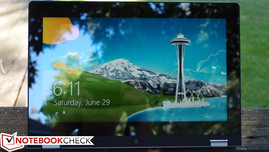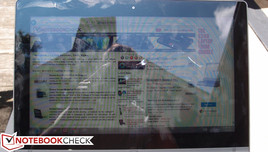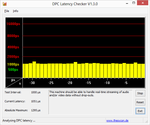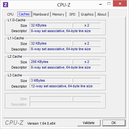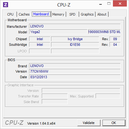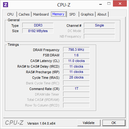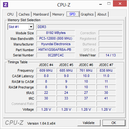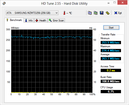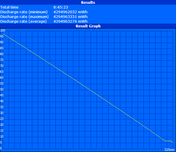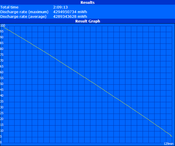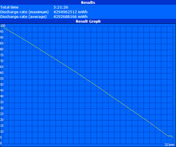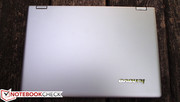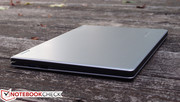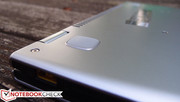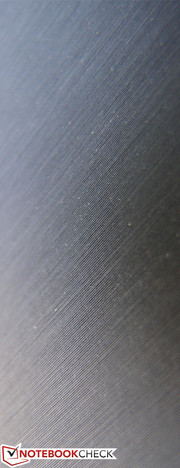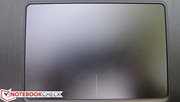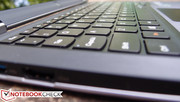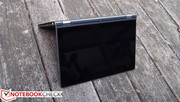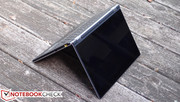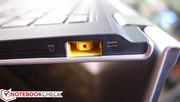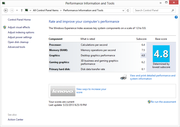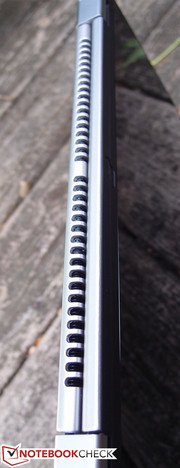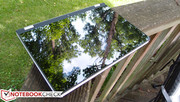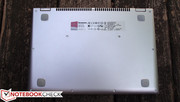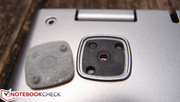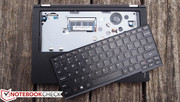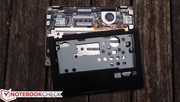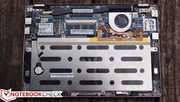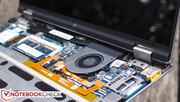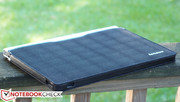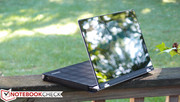Review Lenovo IdeaPad Yoga 11S Ultrabook

Once upon a time, there was the Yoga 11 and Yoga 13. The Yoga 13 was praised for its beautiful, bright display, sturdy build quality, and versatile design, while we criticized its somewhat cumbersome tablet build, average battery life, and disappointing keyboard. Meanwhile, the Yoga 11 enjoyed similar compliments—while boasting an all-day battery life and silent operation—but it was pretty severely handicapped by the limitations of Windows RT. So, then, why not combine the two in an effort to extract the primary benefits of both? That’s precisely what the Yoga 11S represents; it’s nearly identical to the Yoga 11 in terms of appearance and form factor, but it sports the innards of an Ultrabook, exchanging the super-efficient but functionally limited ARM-based Tegra 3 for an ultra-low voltage Intel CPU instead. This grants it the ability to run full-blown Windows 8 and affiliated x86 applications, which nullifies our primary complaint about the Yoga 11.
Our Yoga 11S review unit includes an Intel Core i5-3339Y ULV CPU with integrated Intel HD Graphics 4000. Boasting 8 GB of RAM and a larger SSD, it’s better-equipped to handle the demands of general computing than the Yoga 11’s mobile-grade equipment. But is it worth the unavoidable sacrifice in battery life? As always, we’ll let our flurry of tests and measurements decide.
Case
If you didn’t know any better, you might easily mistake the Yoga 11S for the Yoga 11; after all, the two are nearly identical, with the 11S merely sporting a slightly thicker and heavier build (1.37 kg vs. the Yoga 11’s 1.192 kg—which essentially splits the difference between the weight of the Yoga 11 and 13). Fortunately, it’s an attractive machine, built out of a sturdy, well-fitted plastic casing and polished with a soft-touch rubbery finish that extends along the display lid and bottom of the unit. Meanwhile, the palm rest and trim around the keyboard feature a grooved rubbery finish that’s slightly different from the Yoga 11’s splotchy rubber surface; it’s a nice look, even if it does manage to hold onto dust and grit a little better than a smooth surface.
As always, the Yoga’s claim to fame is its transformative ability, which allows its screen to rotate 360 degrees underneath the base unit to convert into a tablet. Such a feature is certainly taxing on a machine’s hinges, and so it’s fortunate that the Yoga 11S’ are made of stainless steel and feel strong—seemingly more than capable of supporting its acrobatics. Elsewhere, although the machine comes off as durable enough, flex of the base unit and especially the display is easy enough to provoke via twisting. But it doesn’t feel like a problem in practical use.
It’s true that the 11S is smaller than the Yoga 13, but it still feels large and cumbersome as a tablet. This is most certainly a notebook first and a tablet second. Fortunately, the Yoga 11S retains the ability to convert into its other two novel forms known as Tent Mode and Stand Mode. While it might seem gimmicky at first, this actually proves pretty useful in situations where tablet functionality is desirable with a table in front of you. The only complaint is that the hinges, while excellent in every other regard, do allow the screen to wobble slightly under minor vibrations and after each touch, which can be annoying.
The Yoga 11S is not designed to be maintenance-friendly. In order to access the internal components, the keyboard must first be removed, followed by the surrounding bezel. This requires the user to carefully remove rubber feet from the bottom of the unit. Further complicating matters is the fact that the exterior is assembled using Torx screws.
Connectivity
The port selection on the Yoga 11S hasn’t changed much since its predecessor. You still get HDMI and a card reader, plus two USB ports—though now one of those ports has become USB 3.0, which is welcomed. Overall, it’s pretty standard fare in terms of Ultrabook design, though for a tablet, it’s certainly a good variety.
The Yoga 11S also includes a small assortment of requisite buttons to better accommodate its use across its various forms. These include the power button, volume rocker, screen lock, and the Lenovo OneKey Recovery button (which is thankfully recessed into the edge). The Yoga’s edge buttons work well except for in Stand Mode, where the small lip of the rubbery base inhibits access to them while inverted.
Communication
Our Yoga 11S came outfitted with 802.11n WLAN and Bluetooth 4.0 courtesy of the RTL8723A adapter. This is a single-band adapter, meaning that only connections to 2.4 GHz networks are possible. As expected, no Ethernet port exists, nor do WWAN or GPS options.
Accessories
There aren’t many accessories for the Yoga 11S. However, we did receive a Lenovo 11-inch Slot-in Case, which covers most of the unit (leaving around an inch protruding). This case also features convenient cutouts for the edge-mounted buttons so that the base unit and keyboard can be protected by the case while the Yoga is in any of its tablet forms (including Tent Mode and Stand Mode). It feels good and works well enough, though it won’t serve as full protection thanks to the multipurpose (and therefore shorter) design.
Warranty
The Yoga 11S comes standard with a 1-year depot warranty. Additional options are available, including 2 and 3-year warranties for $50 and $100 (respectively) and in-home warranties which include Accidental Damage Protection for about $70 more.
Input Devices
Keyboard
Regardless of mixed consumer sentiments about Lenovo’s AccuType keyboard taking over the brand’s selection of notebooks, it is, by all accounts, an excellent keyboard. However, the one included here on the Yoga 11S is (due to the slim form factor) not the full-blown version. The keys have a rougher plastic finish to them, and—although it’s fully-sized—their travel and feedback doesn’t compare to that of the larger IdeaPad and ThinkPad models. Keypresses are also a bit mushy. The keyboard is not backlit.
Another small gripe is the undersized arrow keys. Some other supplementary keys have also found themselves with shrunken proportions, but it’s nothing majorly upsetting.
One reason for the inclusion of this lackadaisical iteration of the AccuType keyboard is that the keyboard often finds itself facing outward or downward by design on the Yoga, meaning it must be recessed below the surrounding rubber shelf. Still, it would have been nice to see something along the lines of the ThinkPad Helix’s keyboard instead.
Touchpad
The Yoga 11S’ Synaptics touchpad is the same great pad found on the Yoga 11. Its soft-touch surface is large and accommodating, and the integrated buttons are easy to operate, but they never trigger accidentally. Multitouch gestures worked as intended during our time with the notebook. It’s an excellent touchpad for an Ultrabook.
Touchscreen
Naturally, in addition to the keyboard and touchpad, the IdeaPad Yoga 11S also features a touchscreen. Unlike with many convertible notebooks, switching to tablet mode is quick and painless with the Yoga 11S. It’s simple: flip the screen back beyond the 180-degree mark and the keyboard and touchpad are automatically disabled to give way to touch control.
In this case, it’s a 10-point multitouch display (versus the Yoga 11’s 5-point), and it works well. Everything from touch accuracy to gestures functions as expected, and the gyroscopic sensor is good, too.
Display
The IdeaPad Yoga 11S features an 11.6-inch IPS HD display with a 1366x768 resolution, which is okay for an 11-inch notebook, but pales in comparison to the 1080p displays found on many modern tablets and even phones. A large number of 13-inch Ultrabooks have also adopted high resolution displays (see the Dell XPS 13-L322X, ASUS Zenbook UX21A, and Acer Aspire S7), so the Yoga’s 135 DPI is hardly impressive.
However, the rest of its properties are more convincing. From the start, we were impressed by the panel’s good brightness and wide viewing angles. These qualities are hallmarks for many IPS displays, and they’re increasingly common on modern tablets. The edge-to-edge hard plastic bezel is not Gorilla Glass, but it looks and feels nice nonetheless.
Our measurements confirm our initial observations. With an average brightness of 335 cd/m², the display panel on the Yoga 11S is even brighter than that of the Yoga 11 and much brighter than that of the Yoga 13. The resulting contrast ratio suffers slightly thanks to the increased brightness imposing a higher black value of 0.47, but it’s still excellent at 736:1. Only the brightness distribution of 81% is merely average, but that’s still not a bad value overall.
| |||||||||||||||||||||||||
Brightness Distribution: 81 %
Center on Battery: 345.8 cd/m²
Contrast: 736:1 (Black: 0.47 cd/m²)
ΔE Greyscale 3.47 | 0.57-98 Ø5.3
45.67% AdobeRGB 1998 (Argyll 2.2.0 3D)
63.5% sRGB (Argyll 2.2.0 3D)
44.03% Display P3 (Argyll 2.2.0 3D)
Gamma: 2.51
The IdeaPad Yoga 11S panel only manages to cover 62% of sRGB, but because of the excellent contrast ratio and brightness, it’s unlikely that most people will be bothered by this unless they are seriously in need of color accuracy.
Again, CalMan 5 confirms these readings—but at least only two colors are notably off the mark. In this case, it’s Magenta and Blue, which posted DeltaE readings of 10 and 21 respectively (the latter is especially aberrant).
In spite of the glossy edge-to-edge plastic screen, the Yoga 11S is surprisingly usable outdoors—but only thanks to its higher-than-normal panel brightness and great contrast ratio. However, reflections are (predictably) a problem in bright sunlight, and fingerprints on the panel are particularly visible under such circumstances. As was the case with the Yoga 13, the brightness on the Yoga 11S once again drops significantly when moving from level 10 to level 9.
Performance
The Yoga 11S features ultra-low-voltage (ULV) Intel CPUs with a TDP of 13 W, meaning their performance will be notably limited compared with standard-voltage (35 W TDP) counterparts. The options range from a Core i3-3229Y 1.4 GHz CPU all the way to a Core i7-36889Y 1.5 GHz CPU. Our review unit featured a middle-of-the-road Intel Core i5-3339Y, which is also a 1.5 GHz CPU with a maximum Turbo Boost frequency of 2.0 GHz and 1.8 GHz for single- and dual-core operation, respectively.
The i5-3339Y is an Ivy Bridge CPU launched in Q1 2013, and is manufactured using a 22 nm SOI. Its maximum power consumption of 13 W is even 4 W below that of Intel’s more common ULV line of 17 W TDP CPUs, and 6 W below AMD’s lowest-voltage offerings. Its performance compares most closely with the i3-3217U, which is a 1.8 GHz Ivy Bridge CPU with a TDP of 17 W.
In terms of system memory, our review unit included 8 GB DDR3-1600 (PC3-12800) RAM by way of a single DIMM. There is no option for additional memory as 8 GB is the maximum supported. The Yoga 11S’ GPU is the integrated Intel HD Graphics 4000; the particular variant that pairs with our i5-3339Y features a frequency that varies from 350 to 850 MHz depending on system demand.
Our synthetic benchmarks confirm our initial suspicions regarding the i5-3339Y’s performance comparisons with the i3-3217U. However, this is the first notebook we have reviewed with the i5-3339Y. As additional notebooks featuring this CPU arrive and are tested, we will update our database of scores accordingly. For now, the closest comparisons to the performance scores we received are notebooks featuring the i3-3217U, such as the MSI S30-i3U465 Slim, the IdeaPad U510 MBM62GE, and the Toshiba Satellite U940-101. Our benchmarks across wPrime, Cinebench R10, and 3DMark 06 (CPU) score the Yoga 11S within a few percentage points of these competitors in every scenario. The larger Yoga 13, on the other hand, with its i5-3317U, bests it by around 21%.
To discern whether or not full performance was only achievable while running on AC power, we performed a subsequent run of 3DMark 11 while running only on battery power. Our result of P495 (just one point shy of the AC power result) confirms that there is no difference in performance. Finally, DPC Latency Checker also suggests that there should be no problems streaming real-time audio and video.
Processor
As we covered earlier, the Intel Core i5-3339Y’s TDP of just 13 W means that its performance is significantly limited compared to other higher-voltage i5 CPUs. However, its extremely low power consumption means that it should yield better efficiency and generate less heat when compared to higher-voltage CPUs. For context, the Yoga 11 which we reviewed previously was packing a mobile-grade ARM-based chipset (featuring the NVIDIA Tegra 3), so its performance was significantly handicapped and it lacked the ability to run full Windows 8 (though its battery life was also phenomenal). In light of these facts, the i5-3339Y’s comparison to the i3-3217U is not an insult, but rather a confirmation of its ability to stand with higher-voltage CPUs in spite of its power-sipping design.
System Performance
Thanks in large part to the inclusion of a fast solid-state drive (SSD), the IdeaPad Yoga 11S posts an excellent performance score in PCMark 7 of 3935. This is in the range of many modern Ultrabooks, and it reaffirms our subjective impressions of the notebook’s general operation. Meanwhile, PCMark Vantage yields a score of 9066—also a great result. The Windows Experience Index of just 4.8 confirms the bottleneck as the integrated graphics.
| PCMark Vantage Result | 9066 points | |
| PCMark 7 Score | 3935 points | |
Help | ||
Storage Devices
The Yoga 11S is currently available with either a 128 GB or 256 GB SSD. Our review unit included the larger 256 GB model, which happens to be a Samsung PM841 Series MZMTD256HAGM-000L1 SSD. The drive posts very good performance scores (not the best we’ve seen from an SSD to date, but more than quick enough for an Ultrabook). Replacing the SSD is not easy, as nearly the entire machine must be disassembled (and roughly 20 Torx screws removed in the process) in order to reach the SSD.
GPU Performance
The IdeaPad Yoga 11S includes integrated Intel HD Graphics 4000. Depending on the processor with which it is paired, every iteration of this GPU features a different base and Turbo clock rate. In the case of the i5-3339Y, as previously mentioned, the frequencies range from 350 to 850 MHz. However, in spite of its much more capable CPU than the Yoga 11 (and its ability to run mainstream x86 applications), the Yoga 11S still can only handle basic gaming on low settings.
This GPU has been extensively tested on Notebookcheck. For more information and benchmarks on the Intel HD Graphics 4000 GPU, see our review here.
| 3DMark 03 Standard | 8395 points | |
| 3DMark 05 Standard | 6282 points | |
| 3DMark 06 Standard Score | 3566 points | |
| 3DMark Vantage P Result | 2264 points | |
| 3DMark 11 Performance | 496 points | |
Help | ||
| low | med. | high | ultra | |
| StarCraft 2 (2010) | 62 | 20 | 11 | |
| Diablo III (2012) | 35 | 22 | 18 |
Emissions
System Noise
One area where the Yoga 11 dominated was system noise, as its ARM-based chipset supported a fanless design. The Yoga 11S certainly packs more power, but this is one of the sacrifices affiliated with the change. Fortunately, it still isn’t particularly loud. The system is barely audible while idle with a noise level of just 31.8 dB(A). Meanwhile, under load, in most cases, the fan was still merely noticeable with a median reading of just 34.4 dB(A). It’s only under full (and prolonged) system stress that the notebook becomes somewhat noisy, with a maximum reading of 38.6 dB(A) here. However, it’s never annoying and it still isn’t all that loud. These values are better than the Yoga 13’s (which was much noisier while idle) and even slightly superior to that of the ThinkPad Twist.
Noise Level
| Idle |
| 31.8 / 31.9 / 32.1 dB(A) |
| Load |
| 34.4 / 38.6 dB(A) |
 | ||
30 dB silent 40 dB(A) audible 50 dB(A) loud |
||
min: | ||
Temperature
However, while noise may not be a concern, the Yoga 11S is plagued by uncomfortable temperatures, especially while under load. The unit even gets pretty warm while idle, primarily in the region of the exhaust vent on the back of the notebook (which is typical). We recorded a temperature of 35.8 degrees here on the bottom, which is certainly a bit warm under a light workload.
(-) The maximum temperature on the upper side is 47.4 °C / 117 F, compared to the average of 35.3 °C / 96 F, ranging from 19.6 to 55.7 °C for the class Convertible.
(-) The bottom heats up to a maximum of 52.8 °C / 127 F, compared to the average of 36.7 °C / 98 F
(+) In idle usage, the average temperature for the upper side is 29.2 °C / 85 F, compared to the device average of 30.2 °C / 86 F.
(+) The palmrests and touchpad are cooler than skin temperature with a maximum of 31.2 °C / 88.2 F and are therefore cool to the touch.
(-) The average temperature of the palmrest area of similar devices was 28.1 °C / 82.6 F (-3.1 °C / -5.6 F).
Stress Test
We put every machine we review through a stress test using FurMark and Prime95 to see how they can handle full CPU, GPU, and combined load. Most machines cannot maintain full Turbo clock rates under such circumstances; the Yoga 11S is predicted to buckle due to a low TDP of just 13 W and high temperatures under load.
During our full CPU stress test using Prime95, the notebook remarkably maintained full Turbo frequencies (1.8 GHz per core) for the entire duration of the test. Temperatures reached 63 degrees C. On the other hand, during the full GPU stress test, the GPU only reached a Turbo frequency of 750 MHz, most likely due to a persistent temperature of 67 degrees C.
Under full system stress, the CPU’s clock rate dropped to just 798 MHz and the GPU maintained just 600 MHz. It isn’t surprising that a system of this size can’t handle 100% CPU and GPU stress and sustain performance, however, and these circumstances aren’t likely to manifest themselves under typical real-world conditions. To confirm this, we performed a subsequent run of 3DMark 11 after a full hour of full system stress. The resulting score of 496—precisely the same as before—quells any fears of practical limitations.
Speakers
The Yoga 11S’ speakers are actually better than expected, mostly thanks to clear highs and good stereo separation because of their mounting on the edges of the notebook. However, they’re quite a bit louder when positioned on a flat surface, and that’s something that you’ll end up needing to exploit, as the volume level isn’t very high. On top of that, as expected, low- and mid-range frequencies take a serious beating as the tiny drivers struggle to reproduce any sort of respectable full-range audio.
Battery Life
This is an area of interest for the Yoga 11S, as the Yoga 11’s greatest triumph may have been in the area of battery life.
Using Battery Eater Pro, our benchmarks produced results of 8 hours, 45 minutes in the Reader (Idle) test and 2 hours, 9 minutes in the Classic (full load) test. For a more middle-of-the-road, digestible idea of the notebook’s life under typical usage conditions, our Surfing with Wi-Fi test produced a reading of 5 hours, 21 minutes.
As it stands, the 11S’ battery results are better than average, but the problem is not what they are, but rather what they aren’t. As Haswell notebooks have begun shipping and the initial test results have been published, it’s become abundantly clear that battery life measurements everywhere will be seeing a huge improvement as devices move from Ivy Bridge to Haswell chipsets. The current Yoga 11S configurations have missed the boat on Haswell (at least for now), so it won’t be long before these numbers don’t look so impressive. Still, today, they’re better than most other Ultrabooks, even considering the 13 W TDP of the CPU.
Verdict
The Yoga 11S is essentially a blend of the Yoga 11 and Yoga 13; it’s an attempt to leverage the benefits of both models while keeping the affiliated limitations to a minimum. In some ways, it succeeds: with a bright IPS screen, sturdy design, excellent performance, and a responsive, accurate touchscreen, it’s got a lot to like.
However, like its predecessors, its utility boils down to the user’s goals. If you’re looking for a convertible that lasts all day, this isn’t it; that was the goal of the ARM-based IdeaPad Yoga 11, and there are plenty of tablets that meet that criteria as well. If Windows is a requirement and budget isn’t a concern, you’re much better off springing for the ThinkPad Helix, which lasts for two hours longer in our Surfing with Wi-Fi test, and which features a far superior keyboard. Plus, don’t forget that Intel’s Haswell is being ushered in—and with it, a raised bar of battery life standards. None of these notebooks take advantage of that yet, and it's seriously worth considering the wait.
But if you’re watching your wallet, looking to buy now, and you’re simply in the market for a well-built Windows 8 convertible notebook, the Yoga 11S is a solid choice. It’s capable of handling most office tasks, and it’s versatile enough to function well enough as a laptop and at least adequately as a tablet.


 Deutsch
Deutsch English
English Español
Español Français
Français Italiano
Italiano Nederlands
Nederlands Polski
Polski Português
Português Русский
Русский Türkçe
Türkçe Svenska
Svenska Chinese
Chinese Magyar
Magyar
















